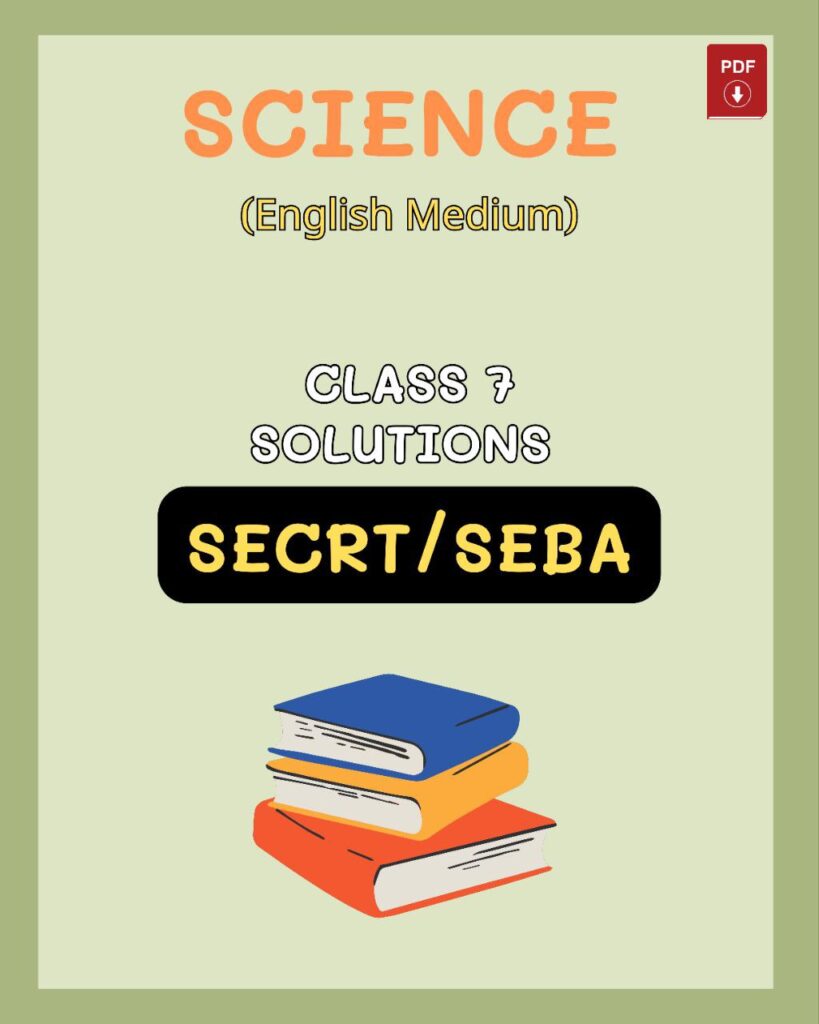SEBA Class 7 Science Chapter 6 Light – Textbook Solutions & MCQ (Part II)
Find Class 7 Science Chapter 6 “Light” Solutions for SEBA Assam (English Medium) students. This chapter, from Part II of the Science book, explains the properties of light, reflection, refraction, plane mirrors, concave and convex mirrors, and their real-life applications. It also covers lenses, formation of images, and how light enables us to see objects. Our solutions include detailed textbook answers, multiple-choice questions (MCQs), and concept explanations to help students understand the topic effectively and perform well in exams.
Class 7 Science
Chapter – 6 (Part II) Ospin Academy
Light
EXERCISE
Q. 1. Fill in the blanks:
(a) An image that cannot be obtained on a
screen is called ________.
Ans: Virtual image.
(b) Image formed by a convex ________ is always virtual and smaller in size.
Ans: Mirror.
(c) An image formed by a _______ mirror is always of the same size as that of the object.
Ans: Plane.
(d) An image which can be obtained on a screen is called a __________ image.
Ans: Real.
(e) An image formed by a concave ______ cannot be obtained on a screen.
Ans: Lens.
Q. 2. Mark ‘T’ if the statement is true and ‘F’ if it is false:
(a) We can obtain an enlarged and erect image by a convex mirror.
Ans: False.
(b) A concave lens always form a virtual image.
Ans: True.
(c) We can obtain a real, enlarged and inverted image by a concave mirror.
Ans: True.
(d) A real image cannot be obtained on a screen.
Ans: False.
(e) A concave mirror always form a real image.
Ans: False.
Q.3. Match the Items given in Column with one more items of Column II.
|
Column – I |
Column – II |
|---|---|
|
(i) A plane mirror. |
(i) Used as a magnifying glass. |
|
(ii) A convex mirror. |
(ii) Can form image of objects spread over a large area. |
|
(iii) A convex lens. |
(iii) Used by dentists to see enlarged image. |
|
(iv) A convex mirror. |
(iv) The image is always inverted and magnified. |
|
(v) A concave lens |
(v) The image is erect and of the same size as the object. |
|
(vi) The image is erect and smaller in size than the object. |
Ans:
|
Column – I |
Column – II |
|---|---|
|
(i) A plane mirror. |
(v) The image is erect and of the same size as the object. |
|
(ii) A convex mirror. |
(ii) Can form image of objects spread over a large area. |
|
(iii) A convex lens. |
(i) Used as a magnifying glass. |
|
(iv) A convex mirror. |
(iii) Used by dentists to see enlarged image. |
|
(v) A concave lens |
(vi) The image is erect and smaller in size than the object. |
Q. 4. State the characteristics of the image formed by a plane mirror.
Ans: (i) Plane mirror forms an erect image.
(ii) It forms a virtual image.
(iii) Size of the image is same as that of the object.
(iv) Image gets formed at the same distance behind the mirror as the object stands in front of it.
(v) Image formed is a laterally inverted image. i.e. right hand side of the object seems to be the left hand side and vice versa.
Q. 5. Find out the letters of English alphabet or any other language known to you in which the image formed in a plane mirror appears exactly like the letter itself. Discuss your findings.
Ans: Letters like A, H, I, M, O, T, U, V, W etc., appear same when seen through a plane mirror.
Q. 6. What is a virtual image? Give one situation where a virtual image is formed.
Ans: The image which cannot be taken on a screen is called a virtual image. When some object is placed very close to the concave mirror we do not get any image of that object on the white screen placed behind the mirror. Such image is called a virtual image.
Q. 7. State two differences between a convex and a concave lens.
Ans:
|
Convex Lens |
Concave Lens |
|---|---|
|
(i) Convex lens can form both real and virtual images. |
(i) Concave lens always form a virtual image. |
|
(ii) It can form mag- nified image. |
(ii) Image is always diminished in size. |
Q.8. Give one use each of a concave and a convex mirror.
Ans: Use of Concave Mirror: Concave mirror is used by dentists to examine the teeth.
Use of Convex Mirror: Convex mirror is used as side view mirror in vehicles.
Q. 9. Which type of mirror can form a real image?
Ans: Concave mirror can form a real image.
Q. 10. Which type of lens forms always a virtual image?
Ans: Convex lens always form a virtual image.
Choose the correct option in questions 11-13:
Q. 11. A virtual image larger than the object can be produced by a:
(i) concave lens
(ii) concave mirror
(iii) convex mirror
(iv) plane mirror.
Ans: (ii) Concave mirror.
Q. 12. David is observing his image in a plane mirror. The distance between the mirror and his image is 4 m. If he moves Im towards the mirror, then the distance between David and his image will be:
(i) 3 m
(ii) 5 m
(iii) 6 m
(iv) 8 m
Ans: (i) 3 m.
Q. 13. The rear view mirror of a car is a plane mirror. A driver is reversing his car at a speed of 2 m/s. The driver sees in his rear view mirror the image of a truck parked behind his car. The speed at which the image of the truck appears to approach the driver will be:
(i) 1 m/s
(ii) 2 m/s
(iii) 4 m/s
(iv) 8 m/s
Ans: (iii) 4 m/s.

Q1: What is the law of reflection of light?
The law of reflection states that the angle of incidence is always equal to the angle of reflection, and the incident ray, reflected ray, and normal all lie on the same plane.
Q2: What is the difference between concave and convex mirrors?
Concave mirrors converge light and can form real or virtual images, while convex mirrors diverge light and always form virtual, diminished images.
Q3: How do lenses help in vision correction?
Convex lenses correct hyperopia (farsightedness) by converging light onto the retina, while concave lenses correct myopia (nearsightedness) by diverging light.
Q4: Where can I find Class 7 Science Chapter 6 solutions for SEBA Assam?
You can find detailed textbook solutions, MCQs, and explanations for SEBA Assam Class 7 Science Chapter 6 (Part II) on this page.
Q5: Where can I find solutions for all Class 7 Science chapters?
To get solutions for all Class 7 Science chapters, Click Here

